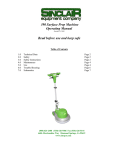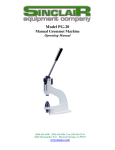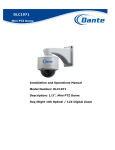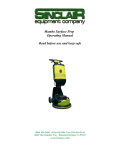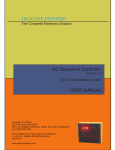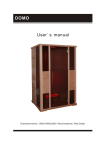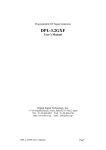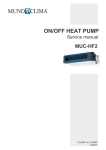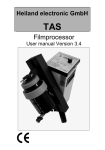Download Sinclair Cutting System User's Manual
Transcript
Cutting System Operating Manual (800) 624-2408 (530) 626-9386 Fax (530) 626-5144 6686 Merchandise Way Diamond Springs, Ca 95619 www.sineqco.com 1 Assembly, Operating and Service Instructions A. Important for your safety! All activities on and with this machine must be carried out in a manner not endangering anyone. Above all, the following precautions must be observed: 1. The adjustable finger guard (512-120) may only be set as high as required for the thickness of the cloth. It may not be removed. 2. Effective safety measures must be taken before commencing any cleaning, repair work, or of changing of any parts. Before doing any of these operations, turn off main switch (51259), pull out the main plug and secure the upper blade. 3. Always switch off the main switch when the machine is not in use. B. Operational Readiness If you follow these directions your cutting machine will always be ready for use. 1. Only the plug your cutting machine into the mains supply voltage indicated on the name plate. 2. Always keep machine and guide rail clean and free from bits of cloth. 3. The correct cutting action of the blades depend on definite pressure between them. Upper blade (512-112) and counter blade (512-110) must form a cutting angle of approx 1degree. The blade pressure can be increased if necessary by turning the adjustment screw (512-101) clockwise. C. Sharpening Blades 1. When the cutting efficiency is diminished, press the grindstone lightly & briefly against the upper blade by means of the press button (512-89). Pressure must not be too hard or a burr will be formed on the edge of the blade. 2. On no account may the upper blade be ground or sharpened on the side facing the counter blade. 3. Clean the grindstone with cleaning fluid. 2 D. Changing Blades 1. 2. 3. 4. Before changing blades, always turn off the main switch and unplug the machine. Remove the finger guard after loosening the knurled nut (512-122). Remove the grindstone assy by loosening the screw (512-91). Loosen tension nut (512-115), then withdraw the tension spring (512-114) and the blade holder (512-113) 5. Remove the upper blade (512-112) 6. The counter blade (512-110) may now be changed as well. It can be pushed up by means of a screwdriver from beneath the sliding plate and can then be withdrawn sideways from its pin hole. The sliding angle (512-95) has two holes to take the counter blade. If smaller well worn upper blades are used, the counter blade may be reset in the second rear hole. 7. Insert and refix new or newly-ground blades in reverse order. E. Lubrication 1. To reduce friction between upper and counter blades an oiler felt produces a constant film of oil on the back of the upper blade. Add 1-2 drops of oil several times a day at the oiler felt cap (512-46). 2. Clean and oil lightly the spring steel strip – guide rail inlay (550-302) occasionally. F. Changing Carbon Brushes After about 250 working hours use, the carbon brushes must be checked. At a minimum length of 6.55 mm they must be replaced by brushes of the same type, size and quality. 1. 2. 3. 4. 5. Turn off main switch and unplug the machine. Undo screws (512-31 and -32) and take off motor housing (512-30). Lift tensioning stirrup of the carbons. Withdraw carbon, pull off cable shoe, and change carbon. Reassemble in reverse order. 3 G. Assembly of guide parts with hand lifting device I. Cutting off equipment: 1. Clamp the near-side support including slide to the table top approx. 40-50cm from the left hand end. 2. Clamp the far-side support, including slide and lifting strap to the table top exactly opposite the near-side support. 3. Feed the lifting strap over the belt rollers (555-286) in the fastening angles (550-273) across the table to the front. 4. Position the guide rail on the fastening angles (550-273) and attach by means of screws (550-227) and nuts (555-264). 5. Pull the lifting strap down behind the near side strap grip until the rail remains horizontal when lifted, and then clamp firmly with screw (555-245). 6. Press the near side switch cam (512-135) into the drilled holes in the guide rail. 7. Fit the far-side switch cam (512-135) into the guide rail so that the rising slope faces the operators side, adjust the cam to suit the width of the material and screw up tightly. 8. Introduce the cutting machine into the guide rail from the operators side and close the stop bolt. 9. Press the handle tube assy (512-203 to 207) on the handle-holder and screw up. 10. It must be possible to raise the device easily by the lifting handle (550-275), the tension springs (555-291), adjustable by means of the spring holders (550-290), act to reduce the weight. 11. Connect the cutting machine to the power supply mains by the connecting lead. First, pass the lead underneath the two pins to prevent the appliance plug being pulled out inadvertently by a pull on the connecting lead. II. End stop and clamping device. 12. Fix table supports to transverse guide rails using hexagon screws m6 x 35 (560-435), nuts and washers. 13. Drill out under the table top location for the table supports, such that the transverse guide rail, seen from above is flush with the edge of table. 14. Attach table supports according to the thickness of the table top, using counter sunk screws m6 x45/60/80 (560-432 thru -434), nuts and washers. 15. Take care that near side and far side transverse guide tracks are parallel. 16. Measure the distance from the traverse guide tracks to the cutting off machine such that settings can be made for maximum and minimum cut lengths. 17. Align the transverse guide rails at the given height. 18. Mount movable supports including end-rail slides on the traverse guide rails at the near side and far side of the table, making sure that they run easily. 19. Carry out assembly of the end rail and tension the strap in the same way as for the cutting off equipment. 20. It is possible to clamp the movable support in any desired position. 4 H. Operation I. Adjustment of length According to the length of cloth required to be cut off, move the end stop and clamping device from the center of the guide rail to the inner side of the end rail until the distance corresponds to the required length of cloth. Lock the movable supports in position by means of the clamping lever (560-415). II. Laying out and clamping down the cloth Draw the cloth over the guide rail up to the inner side of the end rail, taking care that the cloth runs parallel to the longer edge of the table. Raise the end rail until the end of the cloth drops; lower the end rail; the cloth is now clamped. III. Cutting off and clamping down Pull the cutting machine by the handle towards the operators side of the table. The upper blade starts to rotate automatically. The speed at which the cutting machine is pulled across the cloth must be judged to suit the type of material to be cut, and twisting sideways must be avoided. Push the cutting machine back into its starting position until it switches off automatically. Lift the guide rail until the cut material drops down. Lower the rail again and the cut off material is clamped down. The cut-off length of material is now clamped at both ends so that it cannot slip, additional layingout operations can follow until the desired number of layers is reached (up to a max height of 20 cm for the piled layers). 5 Replacement Parts 6 NOTES 7







